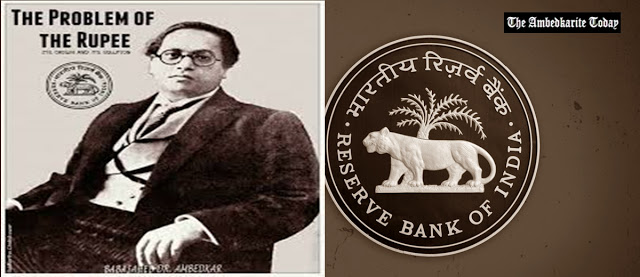The Reserve Bank of India was conceptualised in accordance with the guidelines presented by Dr Ambedkar to the Hilton Young Commission (also known as Royal Commission on Indian Currency and Finance) based on his book, The Problem of the Rupee – Its Origin and Its Solution.
(The legislative assembly passed this under the name of RBI act 1934, its need, working style and its outlook was presented by Dr Ambedkar in-front of Hilton Young Commission. Read, “Evidence before the Royal Commission on Indian Currency and Finance” and “The Problem of the Rupee – It’s origin and it’s solution.” )
Now, walking through the streets of India, on most of the “State Bank of India’s” (SBI’s) street hoardings it shows Rabindranath Tagore as “The banker to this nation”, as if Rabindranath Tagore is the brand ambassador of SBI!
Ambedkar behind the formation of RBI
What hurts many of us is the picture of Mohandas Karmchand Gandhi on the Indian currency. We need to ask everyone what’s the contribution of these two leaders (Rabindranath Tagore and Mr. Gandhi) towards Indian currency, finance and economics, and who deserves to be there on the signposts or on Indian currency?
And have you ever noticed the language panel displayed on Indian rupee banknotes? Sanskrit language is there but not Pali language. Does RBI have any answers? First April is the day when RBI celebrates its foundation day, making April fools of common masses!
If a man with God’s name on his tongue and a sword under his armpit deserved the appellation of a Mahatma, then Mohandas Karamchand Gandhi was a Mahatma. – Babasaheb Ambedkar
Writing about who deserves the place on Indian currency reminds me of a Hollywood movie “Do the Right Thing” directed a way back in 1989 by Spike Lee. Movie revolves around the demand of Afro-Americans to place some pictures of black heroes on the “Wall of Fame” in a pizza shop (where all pictures are of Italian heroes as pizza shop owner is from Italy and very proud of that) as the pizzeria is situated in a black neighbourhood and sells pizza to black people.
At the end of the struggle Afro-Americans succeeded to have a picture of Malcolm X and Martin Luther King, shaking hands on the “Wall of Fame.”

